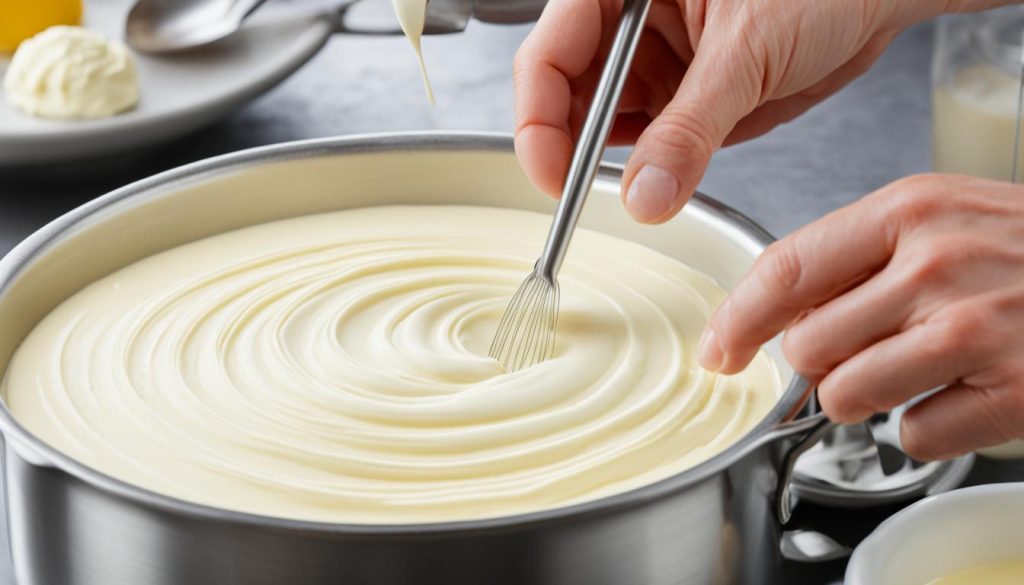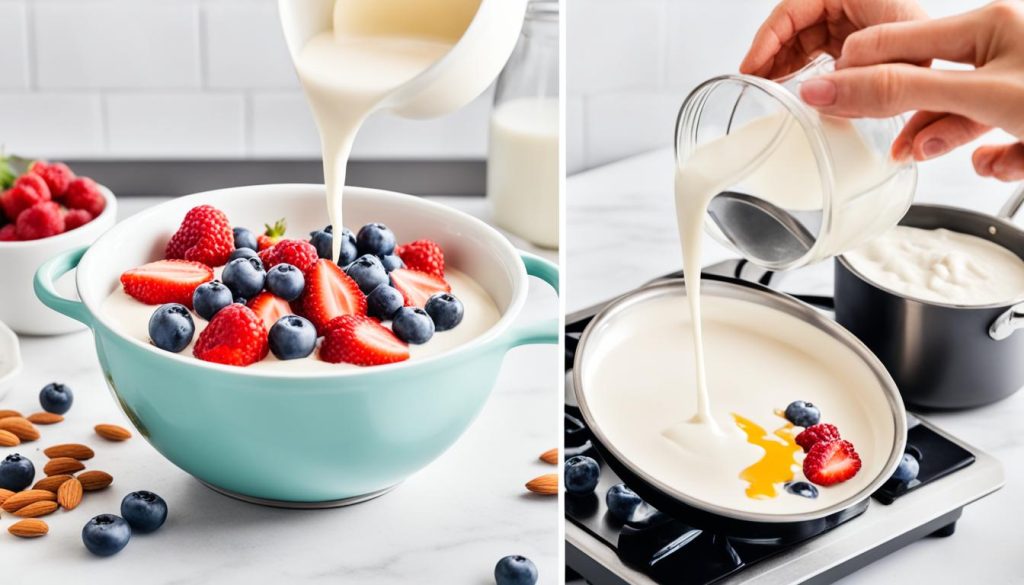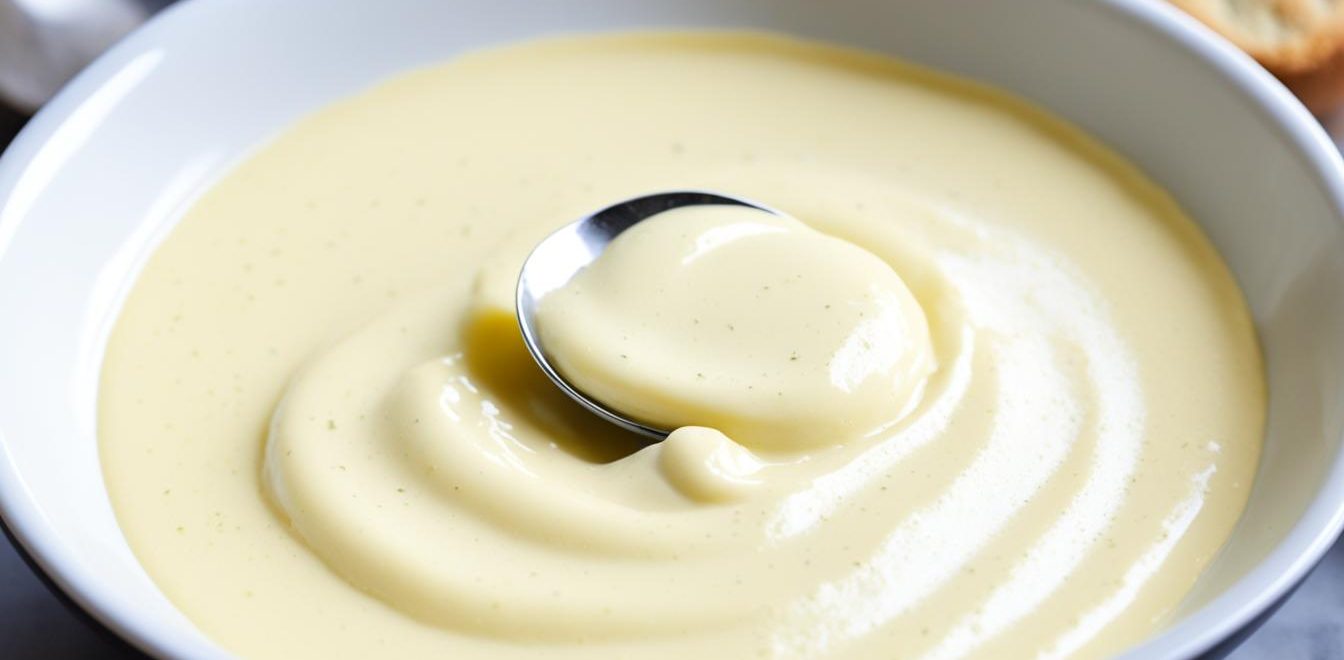Table of Contents
Do you ever wonder how bakeries create those luscious, creamy fillings in their pastries and desserts?
Well, the secret lies in the art of making homemade pastry cream. Whether you want to fill a cake, stuff a cannoli, or layer a tart, mastering the classic pastry cream recipe is a game-changer.
In this article, we will take you on a journey of pastry perfection – from exploring the different variations of pastry cream to learning how to make it from scratch. Get ready to elevate your dessert game with the best pastry cream recipe that will leave everyone asking for seconds.
What is Pastry Cream?
Pastry Cream, also known as Creme Patissiere, is a delicious, rich, and creamy custard that is thickened with starch and eggs. It is commonly used as a filling in pastries and other desserts. Unlike Creme Anglaise, which is a pouring custard, pastry cream has a thicker consistency that can be piped. This creamy delight is cooked to a boil to ensure proper thickening and stability, resulting in a luscious dessert component.
Pastry cream offers versatility, as it can be flavored and used in various dessert creations. From elegant cakes to delectable tarts, this custard provides a smooth and velvety texture, enhancing the overall taste and presentation of desserts. Its luxurious creaminess adds a touch of indulgence to any dessert it is incorporated in.
Check out the image below to visualize the heavenly texture of pastry cream:
Ingredients for Pastry Cream
To make the perfect pastry cream, you’ll need a handful of essential ingredients. These ingredients work together to create a velvety smooth custard that will elevate your desserts to a whole new level of deliciousness.
- Milk: The base of the pastry cream, milk adds a creamy texture. Whole milk is preferred for its richness, but low-fat milk can also be used.
- Eggs: Specifically, egg yolks are used in pastry cream to provide richness and help in the thickening process.
- Cornstarch: Cornstarch acts as a thickener, giving the pastry cream its lusciously thick consistency. It also helps prevent the eggs from curdling during the cooking process.
- Vanilla Extract: The addition of vanilla extract imparts a delightful aroma and flavor to the pastry cream. It adds a touch of sweetness and enhances the overall taste.
- Sugar: Sugar is necessary to sweeten the pastry cream. It balances out the flavors and makes the custard irresistibly delicious.
These ingredients can be adjusted according to your personal preference and the desired consistency of the pastry cream. Feel free to experiment and find the perfect balance that suits your taste buds. Remember, the quality of the ingredients you use will directly impact the final result, so opt for the best you can get.
Now that you know what ingredients to gather, let’s move on to the next step – making the pastry cream!
Making Pastry Cream
Making pastry cream is a delightful culinary process that requires careful attention to detail in order to achieve the perfect consistency and flavor. To make your own delicious pastry cream, follow these simple steps:
- Start by whisking together the eggs, cornstarch, vanilla, and sugar in a bowl. This ensures that all the ingredients are evenly combined before adding the hot milk.
- In a saucepan, heat the milk over medium heat until it reaches a gentle simmer. It’s important to avoid boiling the milk to prevent scorching or curdling.
- Slowly pour the hot milk into the egg mixture while whisking continuously. This process, called tempering, prevents the eggs from curdling and creates a smooth custard base.
- Return the mixture to the saucepan and cook over medium heat, whisking constantly. The heat will activate the cornstarch, thickening the pastry cream.
- Continue whisking until the pastry cream reaches a firm consistency. It should be thick enough to coat the back of a spoon.
- Bring the pastry cream to a boil and let it cook for at least 1 minute. This ensures that the starch is fully cooked and the pastry cream is thickened properly.
- Remember to stir or whisk continuously throughout the cooking process to prevent the eggs from scrambling and to ensure even thickening.
- Once the pastry cream has reached the desired consistency, remove it from the heat and strain it through a fine-mesh sieve. This helps remove any lumps or cooked egg bits, resulting in a smooth and velvety texture.
- Your homemade pastry cream is now ready to be used in your favorite desserts, pastries, or as a delectable filling. Enjoy!
See the image below for a visual representation of the cooking process:
Now that you know the secrets to making the perfect pastry cream, you can confidently create creamy and luscious desserts that will impress your friends and family. Get creative with flavors, fillings, and toppings to take your pastry cream creations to the next level!
Adjusting the Thickness of Pastry Cream
You can easily adjust the thickness of your pastry cream by altering the amount of cornstarch used in the recipe. Cornstarch acts as a natural thickener and helps give the pastry cream its desired consistency. Adding more cornstarch will result in a thicker pastry cream, while reducing the amount will make it softer and more delicate.
If you prefer a softer filling for your dessert, we recommend using 30g of cornstarch. This will create a luscious and creamy pastry cream that has a smooth and velvety texture. On the other hand, if you want a firmer and more stable filling, you can increase the amount of cornstarch to 40g. This will give your pastry cream a slightly denser and more solid consistency.
For an even more firm and stable pastry cream, you can consider adding gelatin to the recipe. Gelatin provides additional structure and helps the pastry cream hold its shape. To incorporate gelatin into your recipe, bloom the gelatin in cold water according to the package instructions, then gently heat it until dissolved. Once the gelatin is fully dissolved, you can add it to your pastry cream mixture and whisk it in thoroughly.
Remember, the proportion of cornstarch and the addition of gelatin can be adjusted according to your specific dessert and personal preference. Feel free to experiment and find the perfect balance of thickness and texture for your pastry cream.

- Classic Vanilla Pastry Cream: A timeless favorite with a smooth and creamy texture.
- Chocolate Pastry Cream: Indulge in the rich and decadent flavor of chocolate in your pastry cream.
- Fruit-Flavored Pastry Cream: Add a burst of fruity goodness to your dessert with a variety of fruit extracts and purees.
Sweetness Level of Pastry Cream
The sweetness level of pastry cream is a crucial factor in achieving the perfect balance of flavors in your desserts. By adjusting the amount of sugar, you can create a pastry cream that suits your individual taste preferences.
For every 2 cups of milk in your pastry cream recipe, it is recommended to use 6 tablespoons (1/4 cup + 2 tablespoons) of sugar. This proportion provides a pleasant level of sweetness that complements a variety of desserts. However, feel free to adjust the amount of sugar based on your personal preference and the specific dessert you are preparing.
For those who prefer a sweeter pastry cream, you can increase the amount of sugar slightly. On the other hand, if you prefer a less sweet filling, you can reduce the amount of sugar accordingly. Adjusting the sweetness level allows you to customize the taste of your pastry cream to perfectly complement the other components of your dessert.
Remember, the sweetness level of your pastry cream is just one aspect of creating a delectable dessert. It’s important to consider the overall flavor profile and the combination of ingredients to achieve a harmonious taste experience. By experimenting and finding the right balance, you can create pastry cream that enhances the flavors of your desserts.
Experimenting with Different Sweeteners
In addition to adjusting the amount of sugar, you can also experiment with different sweeteners to further tailor the sweetness level of your pastry cream. For a unique twist, you can try using alternative sweeteners such as honey, maple syrup, or agave nectar. These options can add a distinct flavor profile to your pastry cream while adjusting the overall sweetness.
Keep in mind that different sweeteners may affect the texture and consistency of your pastry cream. It’s important to follow a recipe specifically designed for alternative sweeteners or make appropriate adjustments to achieve the desired results.
Adjusting the sweetness level of your pastry cream allows you to create desserts that cater to your unique taste preferences. Whether you prefer a sweeter or less sweet filling, experimenting with the amount of sugar and alternative sweeteners can help you achieve the perfect balance of flavors. By customizing the sweetness of your pastry cream, you can elevate your desserts to a whole new level of deliciousness!
Tips for Making the Perfect Pastry Cream
To achieve the perfect pastry cream, follow these helpful tips:
- Heat the milk slowly: When preparing the pastry cream, it is important to heat the milk slowly to avoid scalding. This gradual process ensures that the milk is heated evenly without burning.
- Temper the eggs: To prevent curdling, it is crucial to temper the eggs. Slowly add hot milk to the whisked eggs while continuously whisking. This process gradually raises the temperature of the eggs, allowing them to blend smoothly with the other ingredients.
- Stir constantly: During the cooking process, constant stirring or whisking is necessary to evenly thicken the pastry cream and prevent the formation of lumps. This ensures a smooth and creamy texture.
- Boil for at least 1 minute: Bringing the pastry cream to a boil and cooking it for at least 1 minute is essential to activate the starch and achieve the desired thickness. This step guarantees a stable and firm consistency.
- Strain for a smooth texture: After cooking, it is recommended to strain the pastry cream to remove any lumps or bits of cooked egg. This step ensures a silky and smooth texture.
- Cool thoroughly and cover with plastic wrap: To prevent a skin from forming on the surface of the pastry cream, allow it to cool completely before refrigerating. Once cooled, cover the surface of the pastry cream with plastic wrap, ensuring it touches the surface directly. This prevents air exposure and maintains the freshness of the cream.
By following these tips, you can master the art of making perfect pastry cream, resulting in delectable desserts every time.
Variations and Uses of Pastry Cream
Pastry cream is a versatile ingredient that can elevate the taste and presentation of various desserts. Whether you want to experiment with different flavors or find the perfect filling or topping for your favorite sweet treats, pastry cream offers endless possibilities. Let’s explore the variations and uses of pastry cream that will inspire your culinary creativity.
Pastry Cream Variations:
By adding different extracts, you can create a range of pastry cream variations, each with its own delightful flavor profile. Consider incorporating chocolate extract for a rich and indulgent pastry cream or adding coffee extract for a subtle hint of java. Almond extract can bring a nutty aroma, while citrus extracts like lemon or orange can provide a refreshing and zesty twist. These variations allow you to customize the taste of your pastry cream to complement your dessert perfectly.
Uses of Pastry Cream:
Thanks to its smooth texture and luscious taste, pastry cream can be used in a multitude of desserts. One popular application is using it as a filling for cakes, pastries, tarts, eclairs, and profiteroles. Its creamy consistency pairs beautifully with a variety of doughs and adds a burst of flavor to each bite. If you prefer lighter desserts, try using it as a topping for pies or as a base for cream-based treats like Creme Caramel or Bavarian Cream. The possibilities are truly endless when it comes to incorporating pastry cream into your creations.
Dairy-Free and Gluten-Free Options for Pastry Cream
If you have dietary restrictions or preferences, you don’t have to miss out on enjoying delicious pastry cream. There are dairy-free and gluten-free options available that can be easily substituted in your pastry cream recipe. Let’s explore these alternatives:
Dairy-Free Pastry Cream
To make dairy-free pastry cream, you can replace the traditional milk with plant-based milk. There are various options to choose from, such as almond milk, coconut milk, cashew milk, or soy milk. These alternative milks provide a creamy texture and add their unique flavors to the pastry cream.
Gluten-Free Pastry Cream
If you’re following a gluten-free diet, you can use cornstarch instead of flour as the thickener in your pastry cream recipe. Cornstarch is naturally gluten-free and works just as well in thickening the custard. It ensures a smooth and silky consistency without affecting the flavor.
In addition to the milk substitute, you can also replace the butter with a dairy-free or vegan butter alternative. This ensures that your pastry cream remains completely dairy-free.
By incorporating these substitutions into your pastry cream recipe, you can create a dairy-free and gluten-free version that meets your dietary needs without compromising on taste and texture.

Storing and Freezing Pastry Cream
Once you’ve made your delicious pastry cream, it’s important to store it properly to maintain its freshness. Pastry cream should be stored in the refrigerator in an airtight container to prevent it from absorbing any unwanted flavors or odors. This will help preserve its creamy texture and delicious taste.
To store your pastry cream, simply transfer it to a clean, airtight container and place it in the refrigerator. It is recommended to use the pastry cream within 4 days of making it to ensure the best quality and taste.
Pro tip: To prevent a skin from forming on the surface of your pastry cream, cover it with plastic wrap, making sure the plastic wrap touches the surface directly. This will create a barrier and help maintain the smoothness of the pastry cream.
While refrigeration is the best method for storing pastry cream, freezing it is not recommended. Freezing can cause the cream to separate and affect its texture when thawed. For the best results, it is always advisable to make pastry cream fresh when needed.
By following these storage guidelines, you can enjoy your homemade pastry cream for several days and serve it at its best. Whether you’re filling pastries, creating creamy desserts, or topping your favorite treats, properly storing your pastry cream will ensure it stays fresh and delicious.
Troubleshooting Pastry Cream Issues
While making pastry cream, you may encounter a few common issues that can affect its texture and consistency. The key to troubleshooting these problems lies in understanding the cooking process and making a few simple adjustments.
1. Dealing with Lumps
If your pastry cream has lumps, don’t worry! You can easily remove them and achieve a smooth texture. Simply whisk the pastry cream vigorously to break up the lumps. Another effective method is to pass the cream through a fine-mesh sieve, pushing it through with a spatula. This will help remove any lumps and give your pastry cream a velvety consistency.
2. Correcting Thin Consistency
If your pastry cream is too thin and runny, it may not have been cooked long enough or at the right temperature. The cooking process is crucial to achieve proper thickening. Make sure you cook the pastry cream over medium heat and stir it constantly. This will allow the starch in the cream to activate and thicken the mixture. Cook the pastry cream until it reaches a firm consistency, and make sure to boil it for at least one minute. This will ensure that it sets properly and holds its shape.
3. The Importance of Straining
Straining is an essential step in making pastry cream, as it helps remove any lumps or bits of cooked egg that may have formed during the cooking process. After the pastry cream has thickened and reached the desired consistency, strain it through a fine-mesh sieve. This extra step will give your pastry cream a silky-smooth texture.
By following these troubleshooting tips, you can overcome any challenges and achieve perfect pastry cream every time. With a smooth and creamy texture, your pastry cream will elevate your desserts to the next level of deliciousness!
Conclusion
The perfect pastry cream is a versatile and delicious custard that can elevate any dessert. By following the step-by-step guide and paying attention to the technique and details, you can easily create a velvety-smooth and flavorful pastry cream. From adjusting the thickness to customizing the sweetness and flavor, you have the flexibility to tailor the pastry cream to suit your taste and the specific requirements of your desserts.
Whether you’re filling pastries, topping desserts, or creating cream-based treats, pastry cream adds a touch of richness and elegance that will delight your taste buds. Its creamy texture and luxurious taste make it the perfect complement to a wide range of desserts. So whether you’re planning to make eclairs, tart fillings, or indulgent cake layers, mastering the art of making pastry cream is a skill worth acquiring.
With the right ingredients, careful cooking process, and attention to detail, you can confidently create the perfect pastry cream for all your sweet creations. Make sure to adjust the thickness, sweetness, and flavor to suit your personal preferences and the specific desserts you’re working on. The possibilities are endless, and you can let your creativity shine by experimenting with various extracts and flavor combinations to create your own signature pastry cream. So roll up your sleeves, gather your ingredients, and get ready to take your dessert creations to the next level with the perfect pastry cream.

